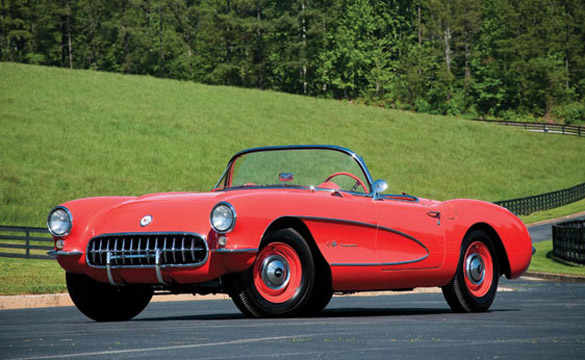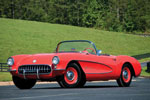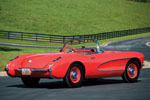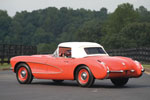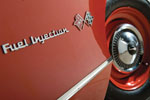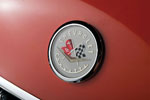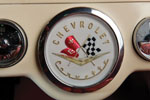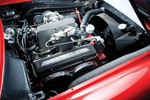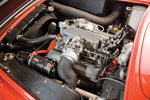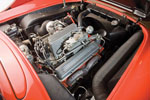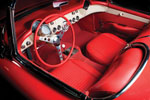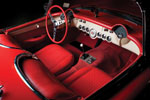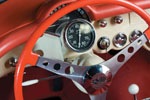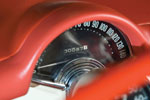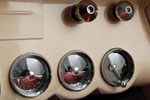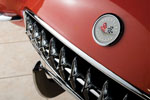RM Auctions descended on Gainesville, Georgia last week to sell one of the largest muscle car collections in the country. Milton Robson’s style was to collect the highest performance vehicle in the model year and series. In his 55-car collection, two Corvettes met his criteria: a 1967 427/435 hp Corvette and the very rare 1957 Corvette with Ramjet airbox fuel injection. There were just 43 factory airbox Corvettes built in 1957 and less than half that amount are believed to be still in existence.
Bidding for the Venetian Red 1957 airbox was heavy and when the hammer dropped, the final bid surpassed the auction estimates of $250,000-$350,000 and sold for $374,000. This was the 5th highest sale of the auction which reportedly netted over 9.2 million.
Here is the catalog description of Miton Robson’s 1957 airbox fuelie Corvette:
In the world of 1957 Corvettes, there are “Fuelies” and then there are “Airboxes.” “Fuelie,” of course, is collector-speak for fuel injection, brand new and milestone status for 1957. The collector’s term Airbox refers to fuel injection plus factory ram air, brand new and meant to pump up the Corvette on the racetrack. Milton Robson’s ’57 convertible is one of a mere 43 Airbox Corvettes built in 1957, of which maybe half remain today.
Specifically, engine option code 579E is the very pricey $726.30 extra racers had to spend if they wanted to compete on the track. (A base Corvette was $3,176.32 for a whole car.) A mere 43 buyers anted up the big bucks to turn their 1957 Corvettes into potential world-beaters. By 1957, Chevrolet’s Corvette was that. In the GT class at the prestigious Sebring road races in Florida, Corvettes finished 1-2, a full 22 laps ahead of the nearest competitor, a Mercedes.
Corvette’s 1957 engine lineup provides the necessary perspective to appreciate the storied Airbox. The base, no-extra-cost 283 was the 220-horse four-barrel. Chevrolet offered a pair of very hot but traditional, dual four-barrel 283s with 245 and 270 horsepower, respectively. The really big deal for 1957 was the arrival of “Ramjet” fuel injection. Chevrolet offered four choices. Both option codes 579A and 579C rated 250 horsepower. Both 579B and 579E rated 283 horsepower. The 283-horse 283 is the fabled one horsepower per cubic inch V-8, a milestone in a passenger car engine that Chevrolet highly publicized.
Of the two option codes with 283 horsepower, 579E has tremendous bragging rights over 579B. With 579E, Chevrolet mounted an 8,000-rpm tachometer on the steering column. This tachometer looks very much like a hot rodder’s mount. However, the white gauge is 100% factory original and so rare that only the privileged have seen one. Its location was more driver-friendly than the factory pod in the center of the dash. With 579E, Chevrolet pulled the factory tachometer and placed a Corvette medallion, as seen on the rear decklid, in the vacated opening.
The other 579E specialty is the highly visible large ducting that funnels outside air from the passenger’s side fender well into the infamous Airbox housing. From here, high-pressure wind blows through the air cleaner element into the mechanical Ramjet fuel injection. This location required Chevrolet engineers to move the interfering generator to the right side of the engine. Here, the fan belt did a better job of spinning the water pump, ultra important with a high-revving engine. The 283’s horsepower peaked at 6,200 rpm.
There’s considerably more to Robson’s Airbox fuelie than the specially tuned ram air 283. Option code 684, called the “Heavy Duty Racing Suspension,” was a necessity for track action. Milton’s fully restored, Venetian Red convertible is one of 51 Corvettes so equipped in 1957. Chevrolet engineers, including Zora Arkus-Duntov, tuned the Corvette for the track with heavier duty springs and shocks, front and rear. They upped the size of the front stabilizer bar. Nothing less than Positraction would do for the rear differential. A quick-steering adapter reduced turns lock-to-lock from 3.5 to 2.9. And last but not least, Chevrolet fitted each wheel with ceramic metallic brake linings with ventilated finned drums. Extra stopping power is extremely important on the track, even if racers did have to heat up the brakes for them to work best.
With a set of 4.11:1 gears, the Airbox Fuelie was capable of 0-60 mph times in the “fives.” (4.56:1 was the lowest available from the factory.) Quarter-mile speeds eclipsed the magic 100 mph mark with elapsed times in the low 14-second range. These figures are stunning considering the bias ply tires of the 1950s and the fact that Chevrolet wasn’t building a muscle car for the drag-strip.
Color is also a big deal to Robson. Venetian Red is hard to beat, looks-wise, for a ’57 Vette. With red, the available interior colors in 1957 were red or beige. Milt’s ’57 is red on red, an amazing find on an original car, which has been restored to perfection, body-off-frame.
Behind the 283/283 Fuelie is a four-speed manual. This transmission may sound de rigueur. However, the three-speed was standard on the Corvette. At the start of the model year, there was no four-speed. They did have the familiar Chevrolet passenger car two-speed Powerglide.
Meanwhile, GM engineers were hard at work designing a four-speed manual utilizing a Borg-Warner box. The four-speed finally made the option sheet in late April of 1957. The arrival of this manual transmission is another reason for Corvette enthusiasts to rejoice in the ’57 model year. Milton persevered to find an original four-speed to fulfill his collecting dream with a 1957 Corvette in an Airbox Fuelie. Adding heavy duty racing suspension is as hot as it got for 1957.
Perhaps one of the most important aspects of this Airbox Corvette is that it also comes with photography, magazine articles and other factory literature that further illustrates just how special this particular Airbox Fuelie is. A very complete and thorough chain of ownership on the car exists, as do period photos of the car in the 1950s with its former owner.
Milton Robson’s style is to collect the highest performance vehicle in the model year and series. The Airbox Fuelie is definitely the king of the 1957 hill, and with its excellent provenance, documentation and condition, it is unmistakable in its overall importance. Addendum
Further to this Airbox Corvette’s rarity, option code “579E” (Airbox) mandated the “684” Heavy Duty Suspension and brakes. 51 cars were built with the Heavy Duty Suspension and brakes alone and only 43 were built with the Airbox (579E), which of course mandated the “684” suspension and brakes. To date, Corvette authorities have located 29 Airbox Corvettes, making this particular example very rare indeed.
Source:
RM Auctions
Related:
Auction Preview: 1957 COPO Air-Box Fuelie Corvette Racer
Rare 1957 “Airbox” Corvette Found & Restored to Former Glory
-

